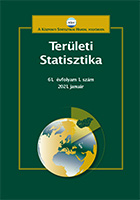A területi egyenlőtlenségek településszintű vizsgálata a történeti Magyarország és utódállamai területén, 1330–2010 (II.)
Long-term study of territorial inequalities at settlement level
in the territory of the historical Hungary and its successor states, 1330–2010 (II)
Author(s): Gábor Demeter, István Papp, Beatrix F. Romhányi, János PénzesSubject(s): History, Social Sciences, Economy, Geography, Regional studies
Published by: Központi Statisztikai Hivatal
Keywords: regional (historical) inequalities; longue durée comparison; hGIS; historical database; gridding-method
Summary/Abstract: We are attempting a longitudinal, historical (1330–2010), fine resolution (settlement-level) comparative analysis in this study of the territorial inequalities in the Kingdom of Hungary and its successor states. Data collection over the last 8 years in 5 time-horizons (1330, 1720, 1786, 1910, 2010) allows the study of almost 300 000 km2 through our databases containing 7 million entries. A study covering such a time span, based on settlement level data series covering an area of similar size is unknown in Europe. The authors, based on their previous results and the work of Acemoglu and Robinson, suggest that current inequalities and differences in development are partly rooted in the past and the knowledge of past causes and processes could help in designing regionally tailored and presumably more successful development policies. Extending the analysis of this well understood phenomenon, in relation to 1910 and 2010 (allowing different political narratives) to earlier historical periods (economic, social and political systems) makes possible an examination of the degree of path dependency (inertia) of each region, too. In the second part of the paper, we will identify, on composite development maps, based on selected indicators, the location of peripheral regions in the five time-horizons (1330, 1720, 1786, 1910, 2010; also symbolising the socio-economic and political systems and social structures), and compare the results with prior historical knowledge. Then, creating the difference maps of the consecutive time horizons, we are illustrating and analysing the nature, extent and dynamism of regional processes (i.e. peripherization) that characterise each historical period (impact of the medieval Turkish rule; Reconstruction – Enlightened absolutism; Reform-era – Dualist bourgeois society; territorial reorganisation – European integration).
Journal: Területi Statisztika
- Issue Year: 63/2023
- Issue No: 03
- Page Range: 300-334
- Page Count: 35
- Language: Hungarian

